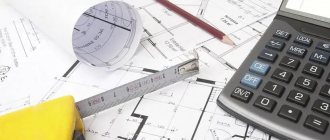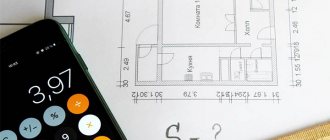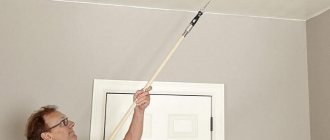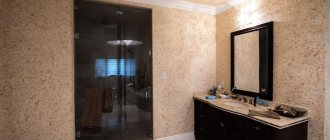Step-by-step calculation of room area
Step 1. First of all, you need to prepare all the measuring tools, as well as a piece of paper and a pen. On paper, you can first draw a diagram of the room, trying to preserve the geometry as much as possible and display all the niches and details of the room. The tape measure used is as long as possible.
Preparing everything you need
Step 2. Measure the length of the room. If it is so large that there is not enough tape measure, then measurements are taken in stages. To begin with, a measurement is made to the maximum length of the tape measure, a mark is made at the end of the tape, from which the measurement is then made again to the end of the room.
First you need to measure the length of the room
Step 3. Measure the width of the room (along the shorter wall). The tape measure is positioned at right angles to the previously measured wall of the room (length). The received data is recorded.
The width of the room is measured
Step 4. The obtained indicators are multiplied among themselves. For these purposes, it is recommended to use a calculator. If necessary, the area value is rounded up.
The resulting figure is rounded up
Step 5. If you need to measure the area of a geometrically complex room, then first the complex figure is divided into several simple ones - squares, triangles, rectangles. The object is depicted schematically on a piece of paper and divided schematically.
The room is divided into 4 rectangles
Step 6. Each figure is measured separately. For example, rectangles, triangles.
Each figure is measured separately
Step 7. The area of each figure is calculated. Next, all the obtained values are summed up and the total exact floor area of the room is obtained.
Example of calculating the area of a triangle
Living area
Before repairs, a careful measurement of everything that exists begins - width, length, height and even diagonals
The fact is that when purchasing building materials, we pay attention to the area for which a particular package, jar, or roll of wallpaper is designed
Calculate the area of the room
To calculate how much wallpaper is needed for one room, you need to make the following measurements:
- Ceiling height
- Width of each wall
- Window and door sizes
- Measure niches and protrusions separately (if the room is non-standard)
Ceiling height can be measured in one place. This is provided that the floor is level and the distance from floor to ceiling will be the same everywhere. Then we measure the width of each wall and multiply by the height. This is the area of a particular wall.
To calculate how much wallpaper you need, you need to sum up the areas of all the walls. But that's all. After all, the room has windows and doors that do not need to be covered with wallpaper. Therefore, we first calculate how much space they take up, and then subtract the result from the resulting total area of the room.
Calculating the square footage of the walls is very important, because as a result of this, we will not only select the right wallpaper or other building materials, but also make the correct estimate for various repairs. Because if you hire workers to repair a residential building, then their services will also be assessed based on the number of square meters
Calculation of floor area
We measure the length and width
Some problems may arise with calculating floor area.
The usual formula for the area of a rectangle S=a×b may not be entirely correct in this case.
It happens when the walls in a house are uneven, as a result of which the width of the floor at the beginning of the room and at the end may be different.
Then they also measure the width in the middle of the room. Having three different results, we calculate the arithmetic mean of these data - all measurements are added up and the sum is divided by the number of these same measurements. The result, although not exact, will be closest to this.
Sometimes there may be a fireplace in the room, or some kind of column, or just a niche. In this case, it becomes more difficult to calculate the required amount of parquet for the floor.
After all, it is not needed under the fireplace, but they also need to cover the ledge from the room. In such cases, you need to subtract from the total area the one that is located under the fireplace or column. Or, on the contrary, add to the total the area of a niche or bay window.
How to calculate the area of a room - step-by-step instructions
You can, of course, look at the technical documentation of the house and see all the necessary characteristics in it. But, firstly, there are often errors, and secondly, sometimes it’s easier to calculate everything yourself than to find documents.
To carry out the calculations, we will need certain tools, most of which can be easily found in every home. Namely:
- roulette;
- pencil;
- note paper;
- calculator (you can use the calculator located on our website);
- sobriety of mind and clarity of thoughts.
To calculate the square footage of the floor in a rectangular or square room, you need to know its length and width.
It is better to take measurements at the base of the walls, and for this it is advisable to move or remove all the furniture. But, if such a procedure was not part of your plans, you can measure in the center. The main thing is that the imaginary line along which the measurement will be made should be located at an angle of 90° to the wall.
After the measurement data has been received and verified, it must be multiplied using the formula, where S is the area in square meters, a and b are the length and width, respectively.
If there is a niche or some other adjacent to the main room, its area must be calculated using the same algorithm, and the results added to the area of the room. If there are various protrusions that occupy part of it, they should also be measured and the resulting result subtracted from the total.
With squares and rectangles everything is simple. How to calculate S of a room if it has an irregular shape? Here you will have to apply logical thinking and remember a little about the school course in algebra and geometry. But let's take things in order.
If the room is of irregular shape
Try to mentally or on paper divide the room into simple elements (squares, rectangles, triangles). Next, you will need to calculate the sizes of each of them and add the results.
- for a triangle - . Where a is the length of the base of the triangle, b is the height drawn from the top to the base;
- for a circle - . Where 3.14, r is the radius of the circle (to find out the radius, use a tape measure to find the longest distance between the walls and divide it by 2);
- for a semicircle - (letter designations coincide with the previous paragraph).
As it turned out, in this case there is nothing complicated. The main thing is to carefully check the measurement results so that a random error does not creep into the calculations and they do not have to be done again.
And further. If you want to install heated floors, do not forget to separately calculate the area occupied by the furniture and subtract it from the total value for the room.
We've sorted out the floor. But when preparing, for example, for re-pasting wallpaper, this will not help you much. You will need to find out the exact number of square meters that the walls occupy.
Walls
The area of each individual wall can be calculated in the same way as the square footage of the floor. Only now, instead of the width of the room, you will need to measure its height. We multiply the length of the wall by the height and get the result we need in square meters.
Measuring height with a laser tape measure
Or you can calculate for all walls at once. To do this, you will need to know the perimeter of the space. Take a tape measure and measure the length of each wall, add up the results - this will be the perimeter. All that remains is to measure the height of the room and use the following formula: , where p is the perimeter, and h is the height.
Now you need to deal with window, door and other openings present in the room.
More precisely, calculate the area of each of them (using the formulas presented above, depending on the shape of the opening), sum the results and subtract them from the total quantity.
There are also a number of general recommendations for taking measurements.
How to calculate the quadrature of a curved room?
Sometimes in rooms one of the corners is “cut off” or the wall is at an angle. Then the same principle of dividing complex figures into simpler ones applies, but some of them will be triangles.
In complex tasks, a good drawing is half the success. Create a floor plan that will help you “divide” the space on paper rather than in your mind.
Sloping corners in a room
In essence, such a room is a rectangle from which a triangle has been “cut off”. Having found the area of this triangle and subtracting it from the total quadrature, the area of the room remains.
The area of a triangle is found by the formula:
S = ab:2
Where a and b are the legs, or sides perpendicular to each other.
The slanted part is the hypotenuse, which is not required for calculations.
- To find out “a”, measure the width of the wall where the cut begins, and then the opposite wall and find the difference between them (for example, the beveled wall is 1.7 m, and the opposite one is 3 m, which means “a” = 1.3 m) .
- “b” is found similarly, only the lengths of the room are compared (for example, 5 m and 3.6 m. Calculation: 5 – 3.6 = 1.4 m).
- The area of the “cut” triangle is calculated (1.3 x 1.4:2 = 1.82:2 = 0.91 m2).
- According to earlier measurements, if the room were rectangular, its dimensions would be 5 m by 3 m. This means that the square is 5 x 3 = 15 m2.
- From the total quadrature we subtract the area of the triangle (15 – 0.91 = 14.09).
Calculation of the ceiling in a trapezoidal room
Many rooms in modern new buildings have a trapezoid shape. In this case, you can calculate the area of the base surface using a specialized formula. As an alternative, the “fragmentation principle” can be applied.
Calculation of the area of a trapezoidal ceiling:
- Draw a sketch of the room. Remember that the drawing must be scaled correctly. Otherwise you will get inaccurate values.
- Measure and add opposite sides of the trapezoid.
- Multiply the sum of the sides by the height of the trapezoid.
- Divide the resulting value by two.
If the trapezoidal room has a sloping ceiling, then measurements are made in a similar way. However, first you need to calculate the area of the side that is perpendicular to the slope. Only after this should you measure the side of the inclined plane. For more accurate measurements, use a laser tape measure. This tool will allow you to calculate an inclined plane without errors.
In addition to the laser tape measure, you will need:
- Building level.
- Long rail.
- Pencil.
- Calculator.
Measuring tools
To correctly calculate the total quadrature you will need a tool such as:
- construction tape of at least 5 meters;
- pen or pencil;
- calculator;
- building level or similar device with a scale;
- stepladder or stool;
- a sheet of paper for notes.
You can also use special services available on the Internet, however, their accuracy is not always correct, and for maximum accuracy it is better to do everything yourself.
Before calculating the area of the walls of the room, it is necessary to provide free access to them and move furniture away to allow unhindered movement
This is very important, because from the initial data obtained from the measurement, we obtain the total volume of the room, as well as the square footage of the ceiling and floor
For maximum accuracy, it is recommended that before taking measurements, mark a straight line slightly above the level of the baseboards using a building level or any other long and level strip. Next, the tape measure is applied horizontally to the surface above the baseboard and the data obtained is recorded on paper. The next step is to measure the distance from the floor to the ceiling, again leaning the tape measure against the wall.
Don't forget to write down all the data you receive.
If the room has the shape of a rectangle, then to obtain the total area of the room it is enough to multiply the resulting width by the length. For example, if a wall is 5 meters long and 3 meters wide, then multiply 5 by 3 to get 15 squares.
Similarly, we measure each wall and add the resulting values into one total. For example, in a rectangular room there are 2 walls of 15 square meters and 2 of 8, we add these values 15x2=30, 8x2=16, 30+16=46. In total, the total surface area of the walls of the room was 46 squares.
Calculation of areas of walls, floors and ceilings
Walls
If the surface of the wall is uniform and does not have any cut-out parts in the form of openings, its area is calculated using one of the formulas for quadrangles, to which it best corresponds. When there are protruding parts in the wall (for example, a stove, a fireplace) or parts that extend beyond its limits, but form one whole with it (for example, niches or bay windows), the area of their vertical projections is subtracted or, conversely, added to the previously calculated one.
Wall area with fireplace
Let's assume that the wall has two openings - a rectangular window and an arched one (consists of a rectangle and a segment placed on top of it). Near the same wall there is a rectangular fireplace, as well as a semicircular niche and a bay window, which has the shape of a trapezoid in plan. From the area of the wall, calculated as a quadrangle, you need to subtract the area of the rectangular and arched openings, as well as the area of the rectangular projection of the fireplace.
That is, you need to calculate the areas of three rectangles and one segment, and then subtract them from the area of the wall. A semicircular niche and a bay window in the plane of the wall also look like rectangles and their areas are also subtracted from the area of the wall. Then you can calculate the areas of the parts of the wall that form the niche and bay window.
For a niche, the length of its arc is calculated and multiplied by its height. For a bay window with a base in the form of a trapezoid, the lengths of its sides are measured, with the exception of the largest, coinciding with the plane of the wall, and also multiplied by its height.
The results obtained must be added to the area of the wall and then its calculated area can be determined with sufficiently high accuracy.
Method of doing the work
Before calculating the square footage of the house, you need to prepare the following:
- Calculator for carrying out calculations.
- Tape measure for taking measurements. It should be borne in mind that some take measurements in inches - they will not fit. You need a tape measure that indicates the length using centimeters.
- You will need an apartment plan. Measurement of the area of walls, floors and ceilings will be performed based on it. If such a diagram cannot be found, then it must be drawn by hand, trying to realistically display the size and geometric shape of the parts.
- You will also need paper and pencil to keep notes as you work.
When measuring floors, walls and ceilings, knowledge from school geometry will first be required. The simplest way to calculate the area of a house in square meters is to calculate rectangular surfaces. The area of a rectangle is calculated as the product of its sides.
Calculation of the area of the simplest geometric figures is based on basic formulas from geometrySource stroychik.ru
It is important to consider the following.
Although the room appears to be made up of rectangular pieces, in reality it may turn out to be a little different. For example, the width of the walls, measured on one side and the other, may differ by several centimeters. This problem is especially significant when measuring distances in old houses. In such cases, the length is usually measured in several places, and the average value is used to calculate the area. Calculations allow you to get the desired numbers with high accuracy
However, it is a wise precaution to add a small amount to the area when calculating. This will eliminate the situation in which there were slightly insufficient building materials.
In this way you can calculate the area of rectangular empty walls, floor and ceiling.
The complex shape of walls and ceilings can be divided into simple shapes to simplify calculationsSource www.buvbaze.lv
Calculation of the area of walls with windows and doors
If there is a window or door on the wall, then the calculation is made as follows:
- The area of the wall is determined without taking into account the door or window.
- The area of each window or door is calculated by multiplying its length by its width.
- The area of windows and doors is subtracted from the area of the wall.
This method is applicable in cases where rectangular walls are considered.
Irregularly shaped wall area
In this case, you need to divide the calculations into stages. A wall with niches can have a complex shape. However, it can always be conditionally divided into several sections, each of which corresponds to one of the simple forms. Then you need to calculate the area of each of the parts and add them up.
How to calculate the area of walls is described in the video
Perimeter calculation
If the room has an irregular shape, then the area of the walls can be calculated by measuring the length of the perimeter. In this case, measure the horizontal segments on each side of the room and add them together, then determine the height. The product of these quantities is equal to the area of the walls in this room.
How to calculate ceiling area
When carrying out renovation work in a residential area, special attention is paid to finishing the ceiling surface
In order to purchase the required amount of building material for finishing work, it is important to initially make all measurements correctly, and then calculate the volume of building materials. As you know, if all the work is carried out by specialists, then they will undertake this work themselves, otherwise they will have to calculate the ceiling area themselves
Although the forms may vary, making preliminary calculations is not as difficult as it might seem at first glance. In order not to make mistakes, you must adhere to all recommendations and use the appropriate formulas during the calculation process.
As you know, if all the work is carried out by specialists, then they will undertake this work themselves, otherwise they will have to calculate the ceiling area themselves. Although the forms may vary, making preliminary calculations is not as difficult as it might seem at first glance. In order not to make mistakes, you must adhere to all recommendations and use the appropriate formulas during the calculation process.
Why are such measurements required?
One of the most common reasons is the ability to calculate the cost of upcoming repairs based on these figures. These data help to preliminary estimate the volume of work being carried out, the prices of specialists, and the amount of necessary materials. To check the competence of the craftsmen and the correct payment for repair work, even if the company offers to take measurements, it is worth calculating the area using the formula in advance to ensure the honesty of the workers. In some cases, this helps to avoid inflated prices, and as you know, some real estate transactions, where area is of great importance, are accompanied by high payment rates.
Carrying out appropriate measurements and the skill of reading diagrams will help to really assess the quality of the living space at any stage of construction, and will also be useful in choosing the option of renting premises or buying and selling an object.
Another interesting use of room area values is lighting planning. A special grid of developed standards has been identified, for which the presence of the area of the illuminated room is of particular importance.
Having S area, it is not difficult to calculate, if necessary, its volume, on the basis of which the need for heating, climate control, and ventilation devices for the coordinated operation of systems is easily calculated.
Important points to consider before making calculations
How to calculate the square footage of the roof of a house? First, you should study the memo for making accurate calculations:
It is necessary to divide a non-rectangular roof into parts of a complex configuration to simplify further calculations
These parts can be triangles, squares, rectangles and so on. To calculate the amount of building material that will cover the roof, it is important to take into account the quality of the coating. The area of a pitched roof for the purchase of soft, galvanized, slate material can be calculated using the formula. S = (Width of overhangs x 2 + Length of the house) x (Width of overhangs x 2 + Width of the house) / cos (Angle of inclination).. If the width of one slope (the segment from the corner of the roof to the ridge) and its length are known for a gable roof, apply the simplest formula for determining the area of a rectangle
Namely: S = A x B. Here A is the length, B is the width. The resulting value is multiplied by two, since there are exactly two stingrays
If the width of one slope (the segment from the corner of the roof to the ridge) and its length are known for a gable roof, the simplest formula is used to determine the area of the rectangle. Namely: S = A x B. Here A is the length, B is the width. The resulting value is multiplied by two, since there are exactly two stingrays.
Calculation diagram for a gable roof
When dividing a roof of a complex shape into several simpler shapes and further carrying out calculations, the formula for the area of a right triangle may be useful: S = 1/2 x A x B. Here the letters A and B indicate the legs, that is, those sides of this geometric figure that are adjacent to right angle of the triangle.
To calculate the area of an isosceles trapezoid (if one of the roof slopes has a regular trapezoidal shape with lateral sides of equal length), in addition to the width of the slope, you need to know the length of the base of the trapezoid (usually the length of the house or a little more) and its height h (a perpendicular segment drawn connecting the top of the ridge and the base of the trapezoidal slope): S = (a + b) / 2 x h.
When dividing the entire surface of the roof into different geometric shapes, you need to arm yourself not only with a tape measure, but also with formulas for calculating the area of a triangle, rectangle, trapezoid and parallelogram.
Final conclusions
The area when using other materials may differ significantly. For this reason, each particular case requires the use of an individual approach, careful analysis and competent calculation. The most difficult situation arises when it is necessary to calculate the square footage of roofs of complex shapes. To get a reliable result, you should follow a few simple rules
:
- The first step is to divide the plane of the roof of the house into several simple geometric shapes. Next, using simple mathematical formulas, you should calculate the area of each simple figure;
- when calculating gable roofs, it is necessary to multiply the resulting quadrature value by the cosine of the angle of inclination of the roof;
- the length of the slopes should be measured from the extreme point of the eaves to the ridge;
- to calculate the absolute area of the roof, it is necessary to calculate the area of all existing elements of the roof structure, and then sum them up;
- Each individual slope can be divided into simple shapes of various shapes, by calculating the area of which you can calculate the quadrature of the slope.
You should know that when calculating the area, it is important not to forget to take into account ventilation ducts, roof windows, chimneys, parapets, hatches and other elements. If this rule is violated, there is a high probability of a shortage of building materials when installing the roof. Correct and competent calculation of the area will provide all the conditions for the optimal expenditure of financial resources associated with the purchase and cutting of material when constructing the roof of a house
Correct and competent calculation of the area will provide all the conditions for the optimal expenditure of financial resources associated with the purchase and cutting of material when constructing the roof of a house.
Room volume
The cubic capacity of a room, or volume in construction, is used when calculating the required heating, ventilation, and air conditioning power of a room.
Volume is measured in cubic meters. The unit is written as 1 m³. From a geometric point of view, the room as a figure is a hexagon.
We recommend: Types and options for constructing fences for private homes. What are the regulations for installation and placement?
By measuring the length, width and height of a rectangular room, multiplying the resulting measurements, you get the volume of a simple room.
The volume of a complex-shaped room is calculated as follows:
- the floor of the room is divided into simple geometric shapes;
- calculate the quadrature of each figure;
- the resulting values are added and multiplied by the height to the ceiling.
How to calculate square meters of a wall with a window
In this case, you need to separately calculate the size of the wall, and separately the size of the window. Then subtract the smaller from the larger area. The result will be the number of square meters that will need to be covered with paint or plaster.
Algorithm of actions:
- Using the scenario already completed, calculate the size of the wall. Let there be an already known number - 15.4 m2.
- Next, measure the height and length of the window. Multiply numbers. For example: length 1.5 m, height 1.2 m. If you multiply, you get 1.8. This means the window area is 1.8 square meters. m.
- We take the area of the wall and subtract the window size from it: 15.4 – 1.8 = 13.6. The area that will need to be tidied up is 13.6 square meters. m.
Living space standards in Moscow, Moscow region and St. Petersburg
Each region sets housing standards in its own regulations. For example, in Moscow there is Law No. 29 “On ensuring the right of Moscow residents to residential premises,” which establishes:
- accounting norm of 10 sq.m. per person for individual apartments and 15 sq.m. for apartments that are provided by court decision to different families.
- the norm for providing housing space per person is 18 square meters. meters.
Based on housing standards, apartments are provided with an area of no more than:
- 44 sq.m. — one-room, for families of two married people;
- 54 sq.m. — two-room apartment, for two residents who are not spouses;
- 62 sq.m. — two-room, family of three, two of whom are married;
- 74 sq.m. - three-room apartment, for three unmarried residents.
Each family member of four or more – 18 sq.m. per person. The resulting area of the apartment cannot exceed 9 sq.m.
Families of Muscovites with disabled people with disorders of the musculoskeletal system are provided with housing in buildings constructed in compliance with the standards of the rehabilitation program.
Law No. 407-65 “On the procedure for keeping records of citizens as those in need of residential premises...”, which is in force in St. Petersburg in relation to living space standards, prescribes them in less detail.
Submission rate:
- a single person is entitled to 33 sq.m.;
- for families where there are two or more people - 18 sq.m.
Registration standard for housing area in St. Petersburg:
- residents of individual apartments – 9 sq. m. total area;
- residents of communal apartments – 15 sq.m. of total area.
The above standards are used when providing separate apartments and rooms in communal apartments.
If the housing is in a dormitory, then the standard is at least 6 sq.m. per person, with a ceiling height of at least 2.1 meters.
How to calculate the area of a room step by step instructions
When calculating the area you need to know the length, width and height of the room
You can, of course, look at the technical documentation of the house and see all the necessary characteristics in it. But, firstly, there are often errors, and secondly, sometimes it’s easier to calculate everything yourself than to find documents.
To carry out the calculations, we will need certain tools, most of which can be easily found in every home. Namely:
- roulette;
- pencil;
- note paper;
- calculator (you can use the calculator located on our website);
- sobriety of mind and clarity of thoughts.
Floor
To calculate the square footage of the floor in a rectangular or square room, you need to know its length and width.
It is better to take measurements at the base of the walls, and for this it is advisable to move or remove all the furniture. But, if such a procedure was not part of your plans, you can measure in the center. The main thing is that the imaginary line along which the measurement will be made should be located at an angle of 90° to the wall.
After the measurement data has been received and verified, it must be multiplied using the formula, where S is the area in square meters, a and b are the length and width, respectively.
If there is a niche or some other adjacent to the main room, its area must be calculated using the same algorithm, and the results added to the area of the room. If there are various protrusions that occupy part of it, they should also be measured and the resulting result subtracted from the total.
With squares and rectangles everything is simple. How to calculate S of a room if it has an irregular shape? Here you will have to apply logical thinking and remember a little about the school course in algebra and geometry. But let's take things in order.
If the room is of irregular shape
Try to mentally or on paper divide the room into simple elements (squares, rectangles, triangles). Next, you will need to calculate the sizes of each of them and add the results.
- for a triangle - . Where a is the length of the base of the triangle, b is the height drawn from the top to the base;
- for a circle - . Where 3.14, r is the radius of the circle (to find out the radius, use a tape measure to find the longest distance between the walls and divide it by 2);
- for a semicircle - (letter designations coincide with the previous paragraph).
As it turned out, in this case there is nothing complicated. The main thing is to carefully check the measurement results so that a random error does not creep into the calculations and they do not have to be done again.
And further. If you want to install heated floors, do not forget to separately calculate the area occupied by the furniture and subtract it from the total value for the room.
We've sorted out the floor. But when preparing, for example, for re-pasting wallpaper, this will not help you much. You will need to find out the exact number of square meters that the walls occupy.
Walls
The area of each individual wall can be calculated in the same way as the square footage of the floor. Only now, instead of the width of the room, you will need to measure its height. We multiply the length of the wall by the height and get the result we need in square meters.
Measuring height with a laser tape measure
Or you can calculate for all walls at once. To do this, you will need to know the perimeter of the space. Take a tape measure and measure the length of each wall, add up the results - this will be the perimeter. All that remains is to measure the height of the room and use the following formula: , where p is the perimeter, and h is the height.
Now you need to deal with window, door and other openings present in the room.
More precisely, calculate the area of each of them (using the formulas presented above, depending on the shape of the opening), sum the results and subtract them from the total quantity.
There are also a number of general recommendations for taking measurements.
Back to school
Calculation of room area
How to calculate the area of a room for wallpapering the ceiling?
For a rectangular room, just multiply its length and width. Thus, the square footage of a room 5.2 m long and 3.8 m wide is equal to 5.2 x 3.8 = 19.76 m2.
What to do with spaces of more complex shape?
- We divide them into the simplest geometric shapes - rectangles and triangles. Since the calculation is performed in preparation for repairs, you can apply markings directly to the old wall finishing coating.
- We measure all sides of each of the figures.
- We calculate the surface quadrature from the obtained measurements. We already remembered how to calculate the area of a rectangle; for a right triangle it is equal to half the product of its legs.
- Let us summarize the results obtained.
A room of complex shape is conventionally divided into simple geometric shapes.
Let's say, if we managed to divide the floor into a rectangle measuring 3x4 m, another rectangle measuring 2x2.5 m and a right triangle with legs 1 and 1.5 m long, the total surface of the floor (and, accordingly, the finished ceiling) of the room will be (3x4) +(2x2.5)+(1x1.5/2)=12+5+0.75=17.75 m2.
Calculation of wall area
To calculate the total surface of solid walls, the same algorithm is used: the length and height of each wall are measured, the measurements are multiplied, after which the results are summed. To get the result minus the openings, you obviously need to first calculate the square footage of each opening, and then subtract the sum of the results obtained from the total area of the walls.
How to find out the quadrature of the surface of a curved wall? Surprise: it is equal to the product of the height and the length of the arc, which is easy to measure with a regular tape measure.
Let's solve another example from a school geometry course.
Given: a rectangular room in a Stalin building measuring 4x5 m with one door (0.8x2.05 m) and two windows (1.2x1.8 m).
Ceiling height – 3.2 m.
- The total area of the walls will be equal to (4x3.2)x2+(5x3.2)x2=57.6 m2.
- The openings will take up (0.8x2.05)+(1.2x1.8)x2=1.64+4.32=5.96 m2.
- Walls minus openings - 57.6-5.96 = 51.64 m2.
To obtain the dimensions of the surface for pasting, it is enough to subtract the total square footage of the openings from the product of the perimeter and the height.
Calculation of the number of wallpapers
How to calculate the amount of wallpaper based on the area of a room or its walls?
The instructions for a rough calculation are extremely simple: the square footage of the surface to be pasted is divided by the area of the wallpaper in the roll, after which the result is multiplied by 1.2 - 1.3 (margin for trimming) and rounded up to a whole number. The more complex the shape of the surface, the greater the required margin for trimming.
So, when pasting the ceiling in a rectangular room measuring 20 square meters, the approximate number of rolls measuring 10x0.6 m will be 20/(10x0.6)x1.2=1.44 (2 packages, taking into account rounding).
It is clear that the accuracy of the result is beyond any criticism: the amount of residue in each roll depends on a very specific length of the strip from wall to wall or from floor to ceiling, but instead of an exact count, we use statistics. If the price per square meter of wallpaper is high enough, it is better to look for a technique that gives greater accuracy.
A calculator that obviously gives inaccurate results.
How to make a more accurate count?
- The width of the surface that is covered with material from one roll is calculated based on the length of one strip (the distance from wall to wall or from floor to ceiling) and the dimensions of the material in one package. Let's say, with a ceiling height of 3.2 meters and a roll measuring 0.6x10 meters, one package will give us the opportunity to stick three strips (10/3.2=3.125) with a total width of 3x0.6=1.8 m.
- Openings are not taken into account when calculating. Why? Yes, because in most cases we have to make a cutout for an opening in an entire strip of wallpaper or in two adjacent strips; The part of the roll corresponding to the opening falls into the scraps.
- The total length of the walls or ceiling is divided by that part of it that will be covered with wallpaper from one roll. So, in a rectangular room measuring 4x5 meters, the perimeter of the walls will be 4x2 + 5x2 = 18 meters; since one package allows you to cover 1.8 meters of wall, we will need 18/1.8 = 10 packages.
In the hallway in the photo, accurate calculations were further complicated by the need to adjust the pattern.
Wallpaper cost calculation
Finally, the simplest stage of calculations. Even an individual who has skipped most of his school lessons can do it with his own hands.
The total cost of purchasing material is obtained by simply multiplying the number of packages of material by the cost of each of them. In order not to test the patience of readers who remember the basics of arithmetic, the author will refrain from giving an example of calculations.
Preparation
And you need to start by preparing the necessary tools:
- calculator;
- pencil, pen or marker - any writing medium plus paper;
- roulette, great if you can find a laser one.
Calculation of a room of the correct shape
The least complex option is a regular rectangular space, which does not have columns, protrusions, niches and other non-standard elements. Under such conditions, the area of the ceiling space is equal to the area of the floor. Therefore, you don’t have to climb upstairs to take measurements; just measure the width and length of the floor. And if you have a laser tape measure, then the task comes down to a few simple movements. But even if you have a regular tape measure, you shouldn’t be upset, since there is nothing complicated about measurements.
It’s most convenient to apply a regular tape measure to the baseboard; if you don’t have one, you can use some kind of slats or a long water level.
So, the floor area is calculated using the formula: Length x Width = Area.
The length and width must be substituted into the formula in meters, and the resulting result will have a different unit - square meter.
For clarity, let's give an example. The width of the room is 4 meters and the length is 5 meters. We calculate the area of the room: 4 x 5 = 20 m2.
If the room has a slightly different shape, for example, in the form of the letter G or P, a similar formula can also be successfully applied. To calculate, you need to divide the area into rectangles.
Irregular shape
Dividing a room into several simple shapes is convenient when it has an irregular shape, for example, an irregular quadrilateral can be divided into two arbitrary triangles.
How to calculate the floor area in this case? You need to calculate this value for each figure using the appropriate formula, and add the results obtained.
Sometimes in the living space there are protrusions and niches that can have very different configurations: rectangular, triangular, round. To calculate the floor area in such a room you need:
- In the diagram, divide it into the main figure and the figure of the ledge or niche.
- Find S for each of them.
- For a niche, its value S must be added to the similar parameter of the main figure; in the case of a protrusion, its value S must be subtracted from the footage of the entire room.
How to prepare for calculations
Carrying out preparatory manipulations consists of preparing the place for measurements. It is also necessary to prepare tools and special accessories. It is better if the room is free of foreign objects. This often happens when taking measurements in a new home or during renovations. Measurements of the length of the sides are made along the walls. In this case, you need to free up at least areas for free movement of the tape measure. The measurement results can be immediately transferred to the diagram. Be sure to check the squareness of the room. To do this, measure diagonal lines.
Features of measurements taking into account communication lines
In addition to the tape measure, you may need a special ruler to check straight lines. This could be a building level or a rule. Sometimes a large construction square is needed. Alternatively, a homemade compass. You can use a piece of cord tied to a sharp pin. For the floor, you can use special measuring accessories. A marker, chalk or tape is suitable for this. Take measurements several times. This will avoid mistakes. Make sure that the measuring tape does not sag. Remember that many measuring instruments have two scales. The metric system and the inch system should not be confused.
The laser device makes the job much easier
Before taking measurements, sketch out a simple plan - a diagram on paper. This will allow all measurements to be distributed correctly. It is worth considering that many calculation formulas are very complex. In this case, it will not be possible to count in a column. To calculate without errors, you can use Excel.
The diagram shows all the necessary measurements for correct calculations
We use online calculators
You can use special calculators - they are available on many construction sites.
A modern area calculator will allow you to carry out all calculations quickly, easily and completely eliminate the possibility of error
It is important that using the online area calculator is extremely simple
Even a person who is not very good with computers can easily figure it out. Most often it consists of several fields:
- height;
- width;
- length.
Enter the parameters of a specific room in the appropriate fields, and in a moment you will receive the exact area of the walls. This means you no longer have to rack your brains about how to find out the area of the room and its walls.
A simple solution to the issue
How to calculate a square meter of walls, ceiling or floor if you have no free time, especially when you are dealing with complex figures, but have the Internet? In this case, the task is significantly simplified. On the Internet you can find a bunch of online calculators that will carry out all the calculations in a few seconds. All you need to do is set the required parameters.
With an online calculator, calculating area is much easier Source doverie-mo.ru
For convenience, all measurements are indicated in different units of measurement, based on specific needs. With their help, any such calculator can easily calculate not only the area of premises, but also land plots. In addition, the obtained result can be converted to any other desired unit of measurement.
General recommendations
To get accurate numbers, builders recommend measuring the wall in three places (at the beginning, middle and end). After which the obtained data should be summed up and divided by 3 and thus the arithmetic mean should be calculated. This procedure helps to avoid errors, even if the walls are not the smoothest.
When measuring window and door openings, you should not calculate the correctness of their shape.
Window opening measurement
It is better to measure all four sides yourself, and not just the two touching ones. This approach will protect you from the consequences of builders’ negligence and unnecessary costs (for example, when replacing windows or doors).
Whatever the reason why you decide to figure out how to calculate the area of a room yourself, remember that it is advisable to do any work efficiently. Therefore, try to carefully plan the entire process, prepare the necessary tools, and feel free to start taking measurements and calculations. And our advice, we hope, will make it easier for you to implement them.
Room area in square meters
It’s not difficult to calculate, you just need to remember the simplest formulas and also take measurements. For this you will need:
- Roulette. It’s better with a lock, but a regular one will do.
- Paper and pencil or pen.
- Calculator (or count in a column or in your head).
A simple set of tools can be found in every household. It’s easier to take measurements with an assistant, but you can do it yourself.
First you need to measure the length of the walls. It is advisable to do this along the walls, but if they are all filled with heavy furniture, you can take measurements in the middle. Only in this case, make sure that the tape measure lies along the walls, and not diagonally - the measurement error will be less.
Rectangular room
If the room is of the correct shape, without protruding parts, it is easy to calculate the area of the room. Measure the length and width and write it down on a piece of paper. Write the numbers in meters, followed by centimeters after the decimal point. For example, length 4.35 m (430 cm), width 3.25 m (325 cm).
How to calculate the area of a room
We multiply the found numbers to get the area of the room in square meters. If we look at our example, we get the following: 4.35 m * 3.25 m = 14.1375 sq. m. In this value, usually two digits are left after the decimal point, which means we round. In total, the calculated square footage of the room is 14.14 square meters.
Irregularly shaped room
If you need to calculate the area of an irregularly shaped room, it is divided into simple shapes - squares, rectangles, triangles. Then they measure all the required dimensions and make calculations using known formulas (found in the table just below).
Before calculating the area of the room, we also make changes. Only in this case there will be not two, but four numbers: the length and width of the protrusion will be added. The dimensions of both pieces are calculated separately.
One example is in the photo. Since both are rectangles, the area is calculated using the same formula: multiply the length by the width. The found figure must be subtracted or added to the size of the room - depending on the configuration.
Room area of complex shape
Using this example, we will show how to calculate the area of a room with a ledge (shown in the photo above):
- We calculate the quadrature without the protrusion: 3.6 m * 8.5 m = 30.6 sq. m.
- We calculate the dimensions of the protruding part: 3.25 m * 0.8 m = 2.6 sq. m.
- Add up two values: 30.6 sq. m. + 2.6 sq. m. = 33.2 sq. m.
There are also rooms with sloping walls. In this case, we divide it so that we get rectangles and a triangle (as in the figure below). As you can see, for this case you need to have five sizes. It could have been broken differently by putting a vertical rather than a horizontal line
It doesn't matter. It just requires a set of simple shapes, and the way to select them is arbitrary
How to calculate the area of an irregularly shaped room
In this case, the order of calculations is as follows:
- We consider the large rectangular part: 6.4 m * 1.4 m = 8.96 sq. m. If we round, we get 9.0 sq.m.
- We calculate a small rectangle: 2.7 m * 1.9 m = 5.13 sq. m. Round up, we get 5.1 sq. m.
- Calculate the area of the triangle. Since it is at a right angle, it is equal to half the area of a rectangle with the same dimensions. (1.3 m * 1.9 m) / 2 = 1.235 sq. m. After rounding we get 1.2 sq. m.
- Now we add everything up to find the total area of the room: 9.0 + 5.1 + 1.2 = 15.3 square meters. m.
The layout of the premises can be very diverse, but you understand the general principle: divide it into simple shapes, measure all the required dimensions, calculate the square footage of each fragment, then add everything up.
Formulas for calculating the area and perimeter of simple geometric shapes
Another important note: the area of the room, floor and ceiling are all the same measurements. There may be differences if there are some semi-columns that do not reach the ceiling
Then the quadrature of these elements is subtracted from the total quadrature. The result is the floor area.
Irregularly shaped room
So, let’s look at specific examples of how to calculate footage:
- Kitchen.
Each kitchen has a ventilation shaft, a radiator along the window, a door, a window and a built-in storage shelf. Let's calculate the clean area of the kitchen walls for wallpapering.
Kitchen details:
Height =2.5 m;
Width=3 m;
Length =3.5m.
Door size: width =0.8 m, height = 2.0 m;
Window size: width 1.2 m, height = 1.5 m;
The ventilation shaft has the following dimensions: width = 50 cm, length = 30 cm; height = 2.5 m;
Radiator dimensions: width = 10 cm, length = 100 cm, height = 50 cm.
Let's calculate the net area:
First, we find the total area: (3.5 m*2)+(3 m*2)*2.5 m = 32.5 m2;
Windows: S net = 1.2 m*1.5 m = 1.8 m2;
Doors: S net = 0.8 m*2.0 m = 1.6 m2;
Ventilation shaft: S net = (50 cm * 2) + (30 cm *2) * 2.5 m = 400 cm2 or 0.40 m2;
Built-in shelf: S net = (20 cm*2) + (50 cm * 2) *2.5 m = 350 cm2 or 0.35 m2;
Radiator surface area: (10 cm *2) + (100 cm *2) * 0.5 m = 110 cm2 or 0.11 m2.
Now we determine the number of net square meters by subtracting their total area: S net kitchen walls = 32.5 m2 - 1.8 m2 - 1.6 m2 - 0.40 m2 - 0.35 m2 - 0.11 m2 = 28, 24 m2.
Helpful advice:
To count the number of wallpaper tubes, you need to divide the net area by the number of sheets in the tube.
The standard tube has the following dimensions: width = 50 cm, length of the canvas = 10 m. The height of the walls of the apartment is 2.5 m, and it follows that one tube of wallpaper includes 4 paper sheets: 10 m / 2.5 m = 4 sheets .
Let's calculate how many pipes are needed to glue the kitchen:
28.24 m2 /4 = 7.06 tubes. But since the paper web can contain a pattern in increments of 0.3 or 0.5, the number of tubes should be rounded to 8.
- Bathroom.
Let's calculate the number of tile boxes for a standard bath. To correctly calculate the square footage of a room, it is necessary to take measurements taking into account the trimming of ceramic tiles.
We know the standard door size: width = 0.8 m; height = 2.0 m.
The size of a typical bathroom is: width 2.3 m; length = 1.6 m, height = 2.5 m.
We calculate the net area of the bath:
S bathtubs = (2.3 m*2) + (1.6 m*2) *2.5 m = 19.5 m2.
Then, subtract the following values:
S net = 19.5 m2 - 1.6 m2 = 17.9 m2.
In order to calculate how many boxes of tiles you need, you should decide on the size of the ceramic product. Tiles come in the following sizes: 10x10; 10x20; 20x30; 30x30. Let's take a more common option: 30x30.
There are 10 pieces in one package and, knowing the size of the tiles, you can calculate the number of pieces per 1 m2:
Let's determine the number of whole tiles and the amount of trimming:
17.9 m2 / 9 = 1.9 - round up and get 20 boxes of whole tiles;
20 * 7 = 140 small tiles, size 10x10.
If you lay the tiles flat without trimming, then you should take 20 boxes, and if with trimming, then 16.
- Balcony.
To get the net area of the balcony, you need to measure the glazed frames. The perimeter of the balcony is measured without taking into account the windows. - Garage.
Typically, a garage is a box with a small window. To calculate the net area, you need to measure the dimensions of the gate.
Try it on
the area of a round window, ceiling, building wall in the form of an irregular shape or an octagon, can be done using improvised means.
Take a tape measure and measure the maximum diameter of the circle, for example, it turned out to be 100 cm. Calculate the radius: 100 cm /2 = 50 cm - this is ¼ of a circle in the form of a triangle.
If we visually divide the circle into 4 parts and connect the points with straight lines, we will get 2 isosceles triangles or 1 square. We know the part of an isosceles triangle, therefore, all sides will be 50 cm. It remains to find the area of a square where all sides are 50 cm. You can calculate the total area of any structure using an online program.
Watch the video in which the master explains in detail how to correctly calculate the area of the walls in an apartment:
How to determine the area of a room in square meters
A few more tips
Before calculating the square footage of the living space, take note of several important nuances:
- The basic unit of measurement for S is square meters;
- If a window or doorway in a wall can almost always be measured in one go, then in the case of the floor and ceiling all actions take place in a certain sequence. Lay out the tape measure, make a mark where it ends, then place it again at the marked point and continue measuring. Do this until you have measured the entire length, and then add up the resulting measurements;
- If the resulting length is more than 1 m, then you need to count both centimeters and meters;
- It is better to measure the length of the wall using the baseboard. For convenience, use the help of a partner;
- When calculating the square meters of the floor, walls or ceiling, be extremely careful. If you are using a regular tape measure, make sure that it is level and that the lock does not slip from the reference point. In the case of a laser tool, make sure that the beam is perpendicular to the wall - otherwise the error in the results will be too large;
- How to calculate the area of a room if its length is slightly more than 1 m? When performing such calculations, round the resulting number to the nearest centimeter and leave millimeters;
- Be sure to convert centimeters to meters. 1 cm = 0.01 m, so to translate it is enough to move the comma 2 digits to the left (for example: 2 m 35 cm = 2.35 m, 8 cm = 0.08 m);
- To get the most accurate measurements, measure the height of the wall in 3 places - at the beginning, end and middle. If the resulting numbers are slightly different (this often happens in old buildings), take the arithmetic average (K + T + M / 3);
- For certain calculations, you need to provide the volume of the room (the so-called cubic capacity). To find out this value, just multiply the width, length and height of the room;
- For those who are not sure of the correctness of their calculations, we advise you to use an online calculator;
- When planning purchases, you need to take into account not only the size of the room, but also the features of the use of certain building materials. This will avoid a lot of waste.
As you can see, there is absolutely nothing complicated in finding the area of a particular room. The main thing is not to rush and remain extremely attentive. Good luck with your calculations!
I like1I don't like
Read further:
Calculation of drywall for walls: calculator, formulas
How to calculate wallpaper rolls, accurate calculation calculator
Grout consumption for tiles per 1 m2 - calculator, calculation formula
Calculation of drywall for a partition - consumption rates, calculator
Basal metabolic rate calculator, most accurate BMR formulas
Ceiling plasterboard calculator
A little theory
How to find the area of various figures was taught in elementary school. This was a long time ago, so an “update” might be helpful. We will only consider what may be related to gender. So, let's start with the simplest thing - units of measurement.
To calculate the area of a room in square meters, you will need a pencil, a tape measure and some knowledge
What is 1 cm² and 1 m²
The area of any figure is measured in square meters or square centimeters. Designation cm² or m², may be written sq.m, sq. cm, sq. meters, sq. centimeters and other variations.
What is one square centimeterOne square centimeter is the area of a square with a side of 1 cm. If you draw a square whose sides are 1 cm, then the shaded part (red or blue in the picture) will be one square centimeter. Accordingly, a square with a side of one meter - 1 m - has an area of one square meter. The same “square area”. That is, this is a square section of floor (or wall) with a side of one meter - 1 m². There are ten thousand square centimeters in one square meter: 1 m² = 10,000 cm².
Formulas
This is what concerned units of measurement and their correspondence. But our premises, thank God, are more than one square meter. How to calculate the area of a room? How many square meters is it? Usually the room has the shape of a rectangle, less often - a square. This means that you will need to remember the formulas for finding the area of a square and a rectangle.
Using very simple formulas, you can calculate the area of a rectangle and square
You need to multiply the lengths of the sides of the rectangle. We get the required area. Let's practice.
- We have a rectangle with sides 80 cm and 50 cm. Multiply these numbers: 80 * 50 = 4000 cm². This will be its area.
- The sides are 322 cm and 300 cm. We get: 322*300 = 96000 cm².
- There is a square with a side of 60 cm. Its area is 60 * 60 = 3600 cm².
In the case of a square, the length of the side can be squared and the result will be the same. But you don’t have to fool your head. It's easier to remember that you need to multiply the sides.
The simplest calculator for calculating the area of a rectangular room.
Converting square centimeters to square meters
When we are dealing with hundreds of centimeters, it is more convenient and easier to count in meters. We know that there are one hundred centimeters in one meter. Let's solve the same examples, but convert centimeters to meters:
- 80 cm = 0.8 m; 50 cm = 0.5 m. Multiply 0.8 * 0.5 = 0.4 m². That is, 0.4 square meters.
- 322 cm is 3.22 m; 300 cm is 3 m. Now we multiply the resulting numbers: 3.22 * 3 = 9.6 m².
- 60 cm are equal to 0.6 m. The area of a square with such a side is 0.6 * 0.6 = 0.36 m².
The numbers are much smaller and easier to remember. And if we want to calculate the area of a room in square meters, we measure its dimensions in meters, not centimeters. You can convert square centimeters to square meters. As has already been said, one square meter contains ten thousand square centimeters.
Ratio of square centimeters to square meters
If you have an area in square centimeters, to convert it to square meters, the figure must be divided by 10,000. For example:
- 4000 cm² / 10000 = 0.4 m²;
- 96000 cm² / 10000 = 9.6 m²;
- 3600 cm² / 10000 = 0.36 m².
As you can see, everything is simple. You just need to remember the basic principles and calculating the area of the room in square meters will not be difficult at all. You will need to take measurements first and then do the calculations.
Tips and tricks
It must be remembered that the geometric parameters of buildings can rarely be ideal. Therefore, to determine exact values, it is better to take measurements in several places and then derive the arithmetic average. For example, when calculating the area of a room based on the walls, it is better to measure the length along the ceiling, baseboard and in the middle of the vertical plane. Height - in the corners and the middle of the wall along a plumb line.
To calculate the perimeter in the presence of many protrusions and niches of different shapes, you need to lay a cord along all the elements, then measure it with a tape measure.
Having calculated the exact parameters, you can go to the store for building materials. It is better to show diagrams with dimensions to the sales consultant. A specialist will help you calculate the consumption of materials, taking into account overlaps, selection of wallpaper patterns or losses when cutting tiles.
Counting the number of tiles
Knowing the area of the room, calculating the amount of flooring will not be difficult. Let's figure out how to figure out how many tiles you will need for a particular room. To do this, you need to find out what the area of one element of the tile covering is. Knowing this data, it is easy to make the necessary calculations. For example:
- room area – 15 m2;
- the size of one unit of tile is 0.20x0.30 m.
Calculation of the number of tiles per floor
Thus, the area of one tile will be 0.2x0.3 = 0.06 m2. Next, we divide the total area of the room by the area of one tile and get: 15/0.06 = 250 units. This is exactly how many tiles will be needed to cover the entire subfloor in a given room. The amount of laminate or parquet boards, as well as other materials, is calculated using exactly the same method.
Video - Calculating linoleum
To calculate the floor area in a room, and then the material consumption, it is enough to know basic mathematical formulas and be able to use a calculator. Having the latter at hand (and now every phone has a calculator), you can make calculations quickly. The main thing is to be careful when taking measurements.











